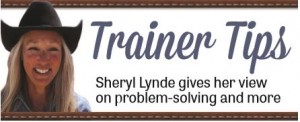 Each horse that comes to me for training teaches me something. As I approach every new horse, I bring my breadth of experience, but also leave a space open to learn. I am receptive to new ideas without any preconceived judgements as to how I can bring out the best in this horse.
Each horse that comes to me for training teaches me something. As I approach every new horse, I bring my breadth of experience, but also leave a space open to learn. I am receptive to new ideas without any preconceived judgements as to how I can bring out the best in this horse.
How much pressure can I use until I get the desired response? How much time can I work on one particular exercise before their resistance turns to frustration and they cease to try? Are they fearful, aggressive, disrespectful? Have they been given enough time to learn the exercise?
There is one consistent theme that I have discovered as a common thread with each horse and that is: Take it slow.
When a parent teaches their infant to sound out words for the first time, they break down each syllable and draw out the sounds slowly and repeat as often as necessary. When the infant makes the desired sound, the parent immediately rewards with facial expressions, tonality in their voice and touch. The infant is able to clearly decipher what sound was made that elicited the positive response. This is the same method used in training both horse and rider.
Break it down, slow it down. Good training takes time. The horse does not learn from pressure, they learn from release — and both the pressure and the release need to be black-and-white and consistent.
For example, when teaching a horse to stand still on a loose rein, the nature of the horse will give you an indication of how long this may take. Obviously a horse that is low in energy will understand the concept quicker than a horse with high energy. But either way, the steps are the same.
First, you have to train the mind, show the horse that standing still is a place to rest. In order to do this you have to first give them the opportunity on a loose rein to do so. If they make a mistake and take off as soon as you drop your rein, then it’s time to go to work.
With your legs, drive your horse into an energetic lope or extended trot. There are many beneficial exercises to work on while in either gait which turns the correction into a training exercise. If you are in the extended trot, you can work on lateral work such as changing directions frequently, making sure your horse leads into the circle with his nose and not his shoulder, getting his rib cage off your calf on both sides in either direction. Continue with this exercise until you have made a difference in softness in the body and lightness in reins. Then when you are on a straight path, relax your body, release your legs and say the word Whoa as you exhale, drawing out the word slowly and loud as you take out the slack in the reins.
Once your horse stops moving their feet, release the reins. If your horse has no intention of standing still when you dropped the reins, then repeat the exercise, but lengthen the time you practice. Repeat as often as necessary for your horse to begin to hunt the stop, wanting to stand still — because walking off is just too much work. You will never be able to force a horse to stand still; however, you can show him the benefits of doing so.
In order to be successful in performing this exercise, you must keep the horse in the extended trot long enough and with enough energy for him to understand that standing still is a better deal. For instance, if you are riding a horse with high energy, you have to feel when he is ready to make the stop. He will start by slowing down his pace, lowering his head and relaxing. When you do say the word , “whoa.” Say it as you exhale, extending the word and say it loud as you relax into the saddle and quit riding. The rider often quits before the horse is ready.
When he does stand still, give him a pat, sit there and relax with him on a loose rein — that is his reward. This exercise does work and will work every time if you give it the time it takes to work. The parent that breaks down the syllables for the infant is confident that by doing so, the infant will be talking, so every effort in patience will pay off. Many riders don’t have the confidence that their efforts will be rewarded with the desired response because they quit too soon. It may take 10 minutes, it may take an hour or a week, but it will work. Follow the steps and you will succeed.
~Sheryl
Leave a Comment
All fields must be filled in to leave a message.